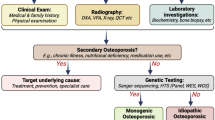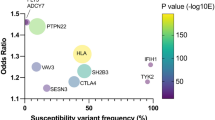Abstract
Spinal osteoarthritis including disc degeneration is a very common condition in the axial skeletons of aged people. Recently, spinal osteoarthritis has been shown to be influenced by specific genetic risk factors. Vertebral osteophytes, endplate sclerosis, and intervertebral disc narrowing are recognized as radiographic features of spinal disc degeneration. HAPLN1 is a key component of the cartilage extracellular matrix; thus, variations in this gene may affect the pathogenesis of cartilage-related diseases such as spinal degeneration. Here, we examine the association between an HAPLN1 gene polymorphism and the radiographic features of spinal degeneration. We evaluated the degree of endplate sclerosis, osteophyte formation, and disc space narrowing in 622 Japanese postmenopausal women. Four SNPs in the HAPLN1 gene—in the 5′ flanking region, intron 1, intron 2, and intron 4—were analyzed using the TaqMan polymerase chain reaction method. We found that compared to subjects with the CC or CT genotype, those with the TT genotype for an SNP at intron 2 (rs179851) were significantly overrepresented among the subjects with higher scores for osteophyte formation (P = 0.0001; odds ratio 2.12; 95% confidence interval 1.45–3.11, as determined by logistic regression analysis) and disc space narrowing (P = 0.0057; odds ratio 1.83; 95% confidence interval 1.19–2.83). Consistent with the involvement of the HAPLN1 gene in cartilage metabolism, a variation in a specific HAPLN1 gene locus may be associated with spinal degeneration.


Similar content being viewed by others
References
Barrett JC, Fry B, Maller J (2005) Haploview: analysis and visualization of LD and haplotype maps. Bioinformatics 21:263–265
Cheung KM, Chan D, Karppinen J, Chen Y, Jim JJ, Yip SP, Ott J, Wong KK, Sham P, Luk KD, Cheah KS, Leong JC, Song YQ (2006) Association of the Taq I allele in vitamin D receptor with degenerative disc disease and disc bulge in a Chinese population. Spine 31:1143–1148
Creamer P, Hochberg MC (1997) Osteoarthritis. Lancet 350:503–508
Czipri M, Otto JM, Cs-Szabó G, Kamath RV, Vermes C, Firneisz G, Kolman KJ, Watanabe H, Li Y, Roughley PJ, Yamada Y, Olsen BR, Glant TT (2003) Genetic rescue of chondrodysplasia and the perinatal lethal effect of cartilage link protein deficiency. J Biol Chem 278:39214–39223
Dudhia J (2005) Aggrecan, aging and assembly in articular cartilage. Cell Mol Life Sci 62:2241–2256
Dudhia J, Bayliss MT, Hardingham TE (1994) Human link protein gene: structure and transcription pattern in chondrocytes. Biochem J 303:329–333
Lane NE, Nevitt MC, Genant HK, Hochberg MC (1993) Reliability of new indices of radiographic osteoarthritis of the hand and hip and lumbar disc degeneration. J Rheumatol 20:1911–1918
Jones G, White C, Sambrook P, Eisman J (1998) Allelic variation in the vitamin D receptor, lifestyle factors and lumbar spinal degenerative disease. Ann Rheum Dis 57:94–99
Kawaguchi Y, Kanamori M, Ishihara H, Ohmori K, Matsui H, Kimura T (2002) The association of lumbar disc disease with vitamin-D receptor gene polymorphism. J Bone Joint Surg Am 84:2022–2028
Kou I, Ikegawa S (2004) SOX9-dependent and -independent transcriptional regulation of human cartilage link protein. J Biol Chem 279:50942–50948
Loughlin J (2003) Genetics of osteoarthritis and potential for drug development. Curr Opin Pharmacol 3:295–299
McKenna LA, Liu H, Sansom PA, Dean MF (1998) An N-terminal peptide from link protein stimulates proteoglycan biosynthesis in human articular cartilage in vitro. Arthritis Rheum 41:157–162
Meulenbelt I, Bijkerk C, de Wildt SC, Miedema HS, Valkenburg HA, Breedveld FC, Pols HA, Te Koppele JM, Sloos VF, Hofman A, Slagboom PE, van Duijn CM (1997) Investigation of the association of the CRTM and CRTL1 genes with radiographically evident osteoarthritis in subjects from the Rotterdam study. Arthritis Rheum 40:1760–1765
Mörgelin M, Paulsson M, Hardingham TE, Heinegård D, Engel J (1988) Cartilage proteoglycans. Assembly with hyaluronate and link protein as studied by electron microscopy. Biochem J 253:175–185
Mwale F, Demers CN, Petit A, Roughley P, Poole AR, Steffen T, Aebi M, Antoniou J (2003) A synthetic peptide of link protein stimulates the biosynthesis of collagens II, IX and proteoglycan by cells of the intervertebral disc. J Cell Biochem 88:1202–1213
Neame PJ, Barry FP (1993) The link proteins. Experientia 49:393–402
Neame PJ, Christner JE, Baker JR (1986) The primary structure of link protein from rat chondrosarcoma proteoglycan aggregate. J Biol Chem 261:3519–3535
Oishi Y, Shimizu K, Katoh T, Nakao H, Yamaura M, Furuko T, Narusawa K, Nakamura T (2003) Lack of association between lumbar disc degeneration and osteophyte formation in elderly Japanese women with back pain. Bone 32(4):405–411
O’Neill TW, McCloskey EV, Kanis JA, Bhalla AK, Reeve J, Reid DM, Todd C, Woolf AD, Silman AJ (1999) The distribution, determinants, and clinical correlates of vertebral osteophytosis: a population based survey. J Rheumatol 26:842–848
Spector TD, MacGregor AJ (2004) Risk factors for osteoarthritis: genetics. Osteoarthritis Cartilage 12:S39–S44
Spicer AP, Joo A, Bowling RA Jr (2003) A hyaluronan binding link protein gene family whose members are physically linked adjacent to chondroitin sulfate proteoglycan core protein genes: the missing links. J Biol Chem 278:21083–21091
Tew SR, Clegg PD, Brew CJ, Redmond CM, Hardingham TE (2007) SOX9 transduction of a human chondrocytic cell line identifies novel genes regulated in primary human chondrocytes and in osteoarthritis. Arthritis Res Ther 9:R107
Urano T, Narusawa K, Kobayashi S, Shiraki M, Horie-Inoue K, Sasaki N, Hosoi T, Ouchi Y, Nakamura T, Inoue S (2010) Association of HTRA1 promoter polymorphism with spinal disc degeneration in Japanese women. J Bone Miner Metab 28:220–226
Urano T, Narusawa K, Shiraki M, Usui T, Sasaki N, Hosoi T, Ouchi Y, Nakamura T, Inoue S (2007) Association of a single nucleotide polymorphism in the WISP1 gene with spinal osteoarthritis in postmenopausal Japanese women. J Bone Miner Metab 25:253–258
Urano T, Narusawa K, Shiraki M, Usui T, Sasaki N, Hosoi T, Ouchi Y, Nakamura T, Inoue S (2008) Association of a single nucleotide polymorphism in the insulin-like growth factor-1 receptor gene with spinal disc degeneration in postmenopausal Japanese women. Spine 33:1256–1261
Urano T, Shiraki M, Narusawa K, Usui T, Sasaki N, Hosoi T, Ouchi Y, Nakamura T, Inoue S (2007) Q89R polymorphism in the LDL receptor-related protein 5 gene is associated with spinal osteoarthritis in postmenopausal Japanese women. Spine 32:25–29
Videman T, Gibbons LE, Battié MC, Maravilla K, Vanninen E, Leppävuori J, Kaprio J, Peltonen L (2001) The relative roles of intragenic polymorphisms of the vitamin D receptor gene in lumbar spine degeneration and bone density. Spine 26:E7–E12
Videman T, Leppävuori J, Kaprio J, Battié MC, Gibbons LE, Peltonen L, Koskenvuo M (1998) Intragenic polymorphisms of the vitamin D receptor gene associated with intervertebral disc degeneration. Spine 23:2477–2485
Watanabe H, Yamada Y (1999) Mice lacking link protein develop dwarfism and craniofacial abnormalities. Nat Genet 21:225–229
Watanabe H, Yamada Y (2002) Chondrodysplasia of gene knockout mice for aggrecan and link protein. Glycoconj J 19:269–273
Yu W, Glüer CC, Fuerst T, Grampp S, Li J, Lu Y, Genant HK (1995) Influence of degenerative joint disease on spinal bone mineral measurements in postmenopausal women. Calcif Tissue Int 57:169–174
Acknowledgments
This work was partly supported by grants from the Japanese Ministry of Health, Labor, Welfare and the Ministry of Culture, Education, Sports, Science and Technology of Japan. This work was also partly supported by a grant from the Japan Anti-Aging Foundation.
Author information
Authors and Affiliations
Corresponding author
Rights and permissions
About this article
Cite this article
Urano, T., Narusawa, K., Shiraki, M. et al. Single-nucleotide polymorphism in the hyaluronan and proteoglycan link protein 1 (HAPLN1) gene is associated with spinal osteophyte formation and disc degeneration in Japanese women. Eur Spine J 20, 572–577 (2011). https://doi.org/10.1007/s00586-010-1598-0
Received:
Revised:
Accepted:
Published:
Issue Date:
DOI: https://doi.org/10.1007/s00586-010-1598-0




